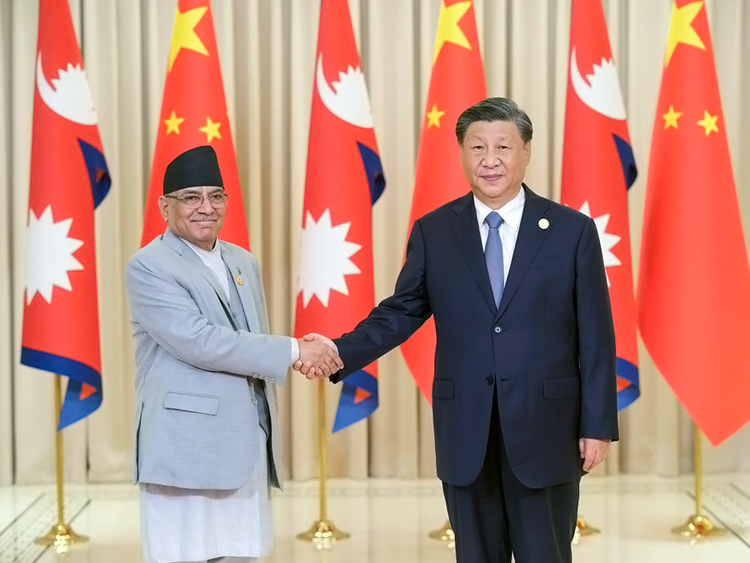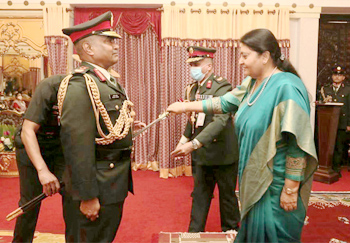INDIAN ARMED FORCES CHIEFS ON OUR RELENTLESS AND FOCUSED PUBLISHING EFFORTS

The insightful articles, inspiring narrations and analytical perspectives presented by the Editorial Team, establish an alluring connect with the reader. My compliments and best wishes to SP Guide Publications.

"Over the past 60 years, the growth of SP Guide Publications has mirrored the rising stature of Indian Navy. Its well-researched and informative magazines on Defence and Aerospace sector have served to shape an educated opinion of our military personnel, policy makers and the public alike. I wish SP's Publication team continued success, fair winds and following seas in all future endeavour!"

Since, its inception in 1964, SP Guide Publications has consistently demonstrated commitment to high-quality journalism in the aerospace and defence sectors, earning a well-deserved reputation as Asia's largest media house in this domain. I wish SP Guide Publications continued success in its pursuit of excellence.
- Operation Sindoor: Resolute yet Restrained
- India’s Operation Sindoor Sends a Clear Message to Terror and the World – ‘ZERO TOLERANCE’
- Japan and India set forth a defence cooperation consultancy framework, talks on tank and jet engines
- Terrorist Attack in Pahalgam in Kashmir: Unfolding a long surgical war against PAK
- Lt General Pratik Sharma takes over Command of Indian Army's Northern Command
Why Nepal Slipped Away
The relationship between India and Nepal has faced challenges in recent years. India will need to make significant efforts to strengthen its ties with Nepal, which has been increasingly drawn towards China.
 |
The Author is former Chief of Staff of a frontline Corps in the North East and a former helicopter pilot. He earlier headed the China & neighbourhood desk at the Defence Intelligence Agency. He retired in July 2020 and held the appointment of Addl DG Information Systems at Army HQ. |


As an Army man, how can I forget to mention that currently, there roughly are 32,000 Gurkhas who make up the 40 battalions serving in the seven regiments in the Indian Army. My course mates who opted to get commissioned into the Gurkha regiments mastered the Gurkhali language and blended so well with their troops that we would secretly make pun of their hugely slowed down cerebral functionalities! They have been celebrated as hardy soldiers and as our very own revered Field Marshal Sam Manekshaw who led the Indian Army to its most astounding victory in 1971 War for liberation of Bangladesh never tired of saying, "If a man says he is not afraid of dying, he is either lying or is a Gurkha".
Nepal — A 'Hindu' Rashtra
While the cry for declaring India a "Hindu Rashtra" is being hotly debated across spectrum, after the consecration of a grand Ram temple at Ayodhya on January 22, 2024, it is not out of place to spare a thought for the only other "Hindu Rashtra" Nepal. It remained the only constitutionally Hindu nation in the world until 2006 when it was declared as a 'secular state'. At 81.19 per cent of the country's population, Nepal accounts for the highest percentage of Hindus of any country in the world (Hindus accounts for a marginally lesser 79.8 per cent in India). Janakpur, a centre for religious and cultural tourism in Nepal, is considered to be the birthplace of Sita. To be fair, Sitamarhi in Bihar also has a claim to be Sita's birthplace. But for a moment we shall put that aside.
At 81.19 per cent of the country's population, Nepal accounts for the highest percentage of Hindus of any country in the world.
It would be natural to assume that relations between India and Nepal should be all hunky-dory given their religious, ethnic, geographical, social and economic affinities. Especially if we view this in the backdrop of the recent bruising spats with Maldives and its hateful "India Out" campaign,underthe recently elected President Muizzu, which in some way gets attributed to radicalisation of the largely Sunni island nation, machinations by Pak-ISI and Chinese influences.
Indo-Nepal Relations: A historical perspective

There are creases in Indo-Nepalese relations that need ironing out, sooner the better. Admittedly, India's colossal asymmetry in size, power, and capability is a massive concern for Nepal. The Indo-Nepal Treaty of Peace and Friendship of 1950 provided for an open border between the two nations, permitting free and unrestricted travel of people and goods. But the absorption of Sikkim into India in 1975 had raised concerns and Nepal insisted on reworking the 1950 treaty. Two trade and transit treaties were signed in 1978 but after two extensions, it was allowed to expire in March 1989, resulting in a virtual Indian economic blockade of Nepal that lasted until late April 1990.
The Indo-Nepal Treaty of Peace and Friendship of 1950 provided for an open border between the two nations, permitting free and unrestricted travel of people and goods.
Among reasons for the souring of relations in the late eighties is said to be rooted in an incident of 1988 when former Prime Minister Rajiv Gandhi was on a trip to Nepal. His wife, Sonia Gandhi was not permitted entry to the Pashupatinath Temple where only Hindus are allowed. When Rajiv Gandhi made personal requests to King Bikram Singh, the later pleaded helplessness in matters of faith. It is said that a miffed Rajiv decided to impose a blockade on Nepal in 1989-90, crippling the landlocked country's economy. The official reason touted was Nepal's hard-line position on trade and transit and procuring weapons from China which had annoyed India.

The timing couldn't have been worse. India's economy had begun floundering by then, with a balance of payment crisis arising out of the combined effects of break-up of the Soviet Union which was our largest trading partner and the oil shock after US invasion of Iraq in 1991. By this time China had seen through a decade of transformative reforms under Deng, overcome the 1989 Tiananmen Square protests and massacre; and begun registering double digit growth from a paltry 2.3 per cent in the earlier decades. It had embarked on using its new-found economic clout to influence its neighbourhood. The hardship faced by Nepal due to the Indian blockade opened up opportunities for China.
The hardship faced by Nepal due to the Indian blockade opened up opportunities for China.

By mid-nineties, there were several domestic frustrations in Nepal like poverty, discontent with repressive policies, and corruption under the monarchy that fuelled a Maoist movement.On February 1, 2005, King Gyanendra, who had himself come to occupy the throne after the shock royal massacre of June 1, 2001 sacked Prime Minister Sher Bahadur Deuba, took power directly and declared a state of emergency. This move strengthened the Maoist insurgents and made Nepal's civil war even more intense. Nepal looked to China for arms to combat the Maoist revolt after India, the nation's biggest arms supplier, the US and Britain suspended military aid following King Gyanendra's seizure of power. That opened a big door for the Chinese, just like it did in Sri Lanka which was battling the LTTE.
Political Upheavals and Transitions
When a CPN(M) led coalition finally came to power after the 2006 Jana Andolan (people's movement)-II, it led to the overthrow of the monarchy. On May 19, 2006, the interim government proclaimed Nepal to be a secular state.
Almost all formulations that took power since 2006, with strong imprints of Chinese meddling,including the Nepali Congress taking hostile positions vis-à-vis India, even provoking New Delhi by accusing it of grabbing Nepali land, issuing maps that showed disputed Kalapani-Limpiadhura-Lipulekh territory as part of Nepal, and getting these changes included in their Constitution.
Hindu nationalism has surged in Nepal as a counter to the rise in ethnic and linguistic nationalism.
The Pakistan ISI has been using Nepal, like it does in Bangladesh, as transit points to pump in fake currency, arms and drugs into India. The arrest of Indian Mujahideen (IM) top operative Yasin Bhatkal and Lashkar-e-Taiba operative Abdul Karim Tunda in August last year brought back the spotlight on the porous Indo-Nepal border and the lack of an extradition treaty with the country.
The Religious, Cultural and Economical Umbilical Cord

From religious and cultural linkages to 'roti-beti' (food and marriage) ties, Nepal understands its economic dependency on India. The Nepali rupee is pegged to India's, landlocked Nepal relies on Indian ports for trade, and six million Nepalis work in India. More than 32,000 Gorkhas serve the Indian Army and the Army Chiefs of both countries hold honorary ranks in each other's armies. Yet the relationship is tenuous and testy at best.
Will the tide change now? Some festering undercurrents point in that direction. Hindu nationalism has surged in Nepal as a counter to the rise in ethnic and linguistic nationalism as well as in response to the increased presence of Christian missionaries in the Nepali hinterlands. In August last year, a group of people led by former Nepal Army General Katawal launched a campaign for the restoration of Nepal as a Hindu state. The demand for a Hindu nation has gone hand in hand with the demand for the return of the monarchy. This is because the monarchy has meshed with Hinduism and the monarch has been regarded as the avatar of the Hindu deity, Vishnu.
Nepalis like to assert their own identity, often "othering" India, but in this case, the Hindu nationalists on both sides of the border may have found a common cause.





